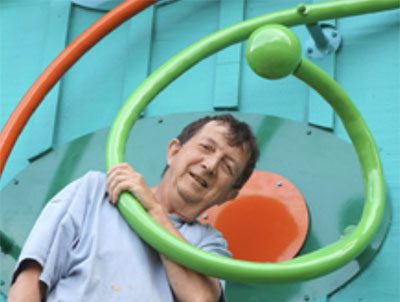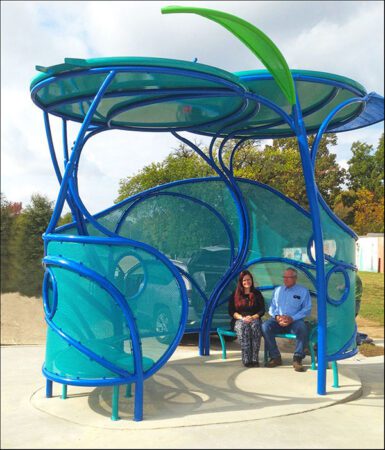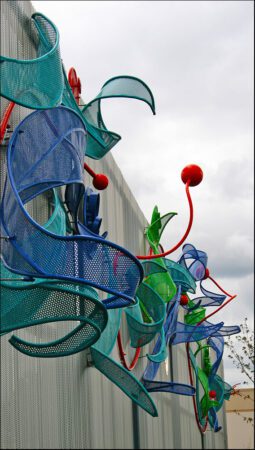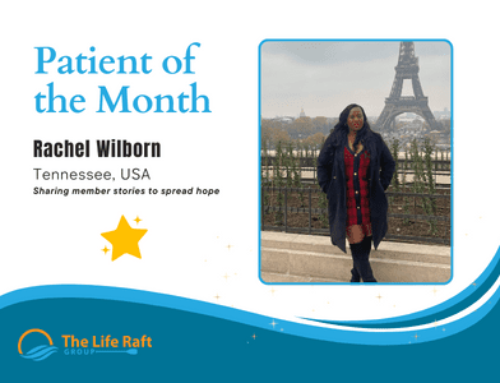Artistic expression is an important psychosocial activity. Sometimes we can express ourselves visually or musically when we can’t express our experience verbally. Music, drawing, painting, and creating sculpture provide a means of communication and self-expression— and a way to alleviate stress. Art also helps us to change our moods, come out of depression, or simply relax. What do people who are already creative do when they are faced with a cancer diagnosis? Does it help or give hope in the situation? In this two-part series, these GISTers – professional and amateur creatives, share their stories.

Tim Watkins, Sculptor & Public Artist
You may have spotted a creation by May + Watkins Design and not even realized it. They create public art, or industrial sculptures – art that is commissioned for public spaces. The partnership of artists, Carol May and Tim Watkins, began after meeting as 20-somethings on scholarship at the Skowhegan School of Painting & Sculpture in Maine. Married for almost 40 years, he is a sculptor; she, a painter. They joined their creative energies professionally in the 90s appreciating their complementary styles, for an illustrative, enduring career creating public works of art.
“We decided to give up our personal shows and that routine because we decided to work together to do public art – because it’s in the public and it’s not hidden away – it’s for everyone, out there,” said Tim.
“Our process? We fight. We have strong discussions. Carol is the brains. She is very creative and I’m more mechanical. Our skills mesh very well. She’ll start doing sketches and I’ll research materials.”

Oasis, May+ Watkins Design, Memphis, TN
Tim Watson’s GIST journey intersected with his artistic path in 2008, when a seven-pound tumor was removed from his abdomen. The couple had never heard of GIST and the information available at the time was dismal and sparse. To date, Tim has been on several drug treatments and is currently on ripretinib. Though there have been many side effects along the way, the most poignant effect was on how he views life and art now.
“I do have a little trouble dealing with the idea of GIST being terminal, but I have a clock ticking louder than it used to tick in terms of how long I’ll be around. It’s something I’ve given a lot of thought to. I am older and now I have this diagnosis, but it has not hamstrung me. All the things we look at are statistics but we are not statistics,” said Tim. “Yes, I’d say this diagnosis has given me a finality. A sense of purpose. I want to keep ‘making’ art because it’s what I love to do. It’s awesome for the little model to became an 18-foot sculpture.”
Tim shared more on creativity and the drive to create.
“It is the answer for me, speaking in terms of spirituality. The answer to ‘why am I here?’ I came to art late, in my teens, searching for what was going to satisfy me. Money wasn’t it. It’s not a priority for me. What’s going to make my life meaningful here on earth? I was looking and I stumbled into art. My original idea was to teach art and history and I took classes and I fell in love with making art.”
The seed for public art was planted during Tim and Carol’s time at Skowhegan.

Leaf Dance, May + Watkins Design, Oregon City, OR
“One of the lecturers there spoke about public art and it made sense to me getting it out there. It’s not just a commodity, a product. It’s meant to be shared and experienced by all. My first installation was created in 1979. Our careers were still separate, we weren’t working together yet, she was still painting and showing. This has been our lives, making art.”
Tim dismisses the thought that public art is somehow less personal than a Rembrandt or a Picasso. The nature of the work is that it is commissioned and several artists will compete by jury to win the commission. The jury appraises the individual proposals and the artists’ portfolio of previous installations and though the proposed designs are unique they need to meet a specific criteria.
“It’s very personal, we’re very proud of it. Is it on the level or Rembrandt or Goya? No, it’s not like that. I love that people get to experience our art on a bigger level than they would if it was in a gallery. Offering a ladder of understanding, you can enter it, say it’s fun. That’s what an artist is. The projects have a lot of our personality. Whimsical. We get to be kids.”
Tim says that Covid-19 hasn’t slowed down their work much considering that most government agencies had money for these types of installation already set in their budgets for 2020. He admits that he and Carol could retire if they wanted to, but he says, “What does that mean? We’d just find another way to make art.”
View more of May + Watkins inspiring designs at: https://maywatkinsdesign.com




